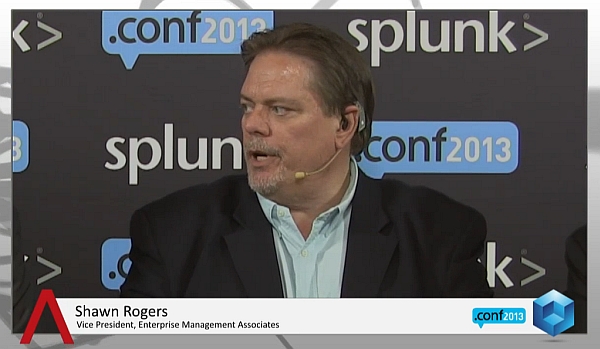 NEWS
NEWS
 NEWS
NEWS
 NEWS
NEWS
![]() “Saving the best for last” at Splunk.conf 2013 in Las Vegas, our program hosts John Furrier and Dave Vellante invited Shawn Rogers to theCUBE, to talk about the newest releases from Splunk, the trends, while also recapping the whole event.
“Saving the best for last” at Splunk.conf 2013 in Las Vegas, our program hosts John Furrier and Dave Vellante invited Shawn Rogers to theCUBE, to talk about the newest releases from Splunk, the trends, while also recapping the whole event.
Shawn Rogers is the Vice President of Research, Business Intelligence and Data Warehousing with Enterprise Management Associates and has more than 20 years of IT experience, with a focus on Internet-enabled technology. He is passionate about analytics, social media, business intelligence, cloud, Big Data, collaboration and open source.
His interview revealed that he was pretty sold on Splunk 6, but it touched a wider range of topics, including Splunk IPO, the recently launched cloud, as well as the trend of moving out of IT and into BI. Among the features of Splunk 6 he likes the most is the data model, which is going to make it more open and accessible to other tools. Splunk is also going to move from the IT management side to a new set of users (more business-oriented decision makers).
Asked who has done the best jobs moving from IT to business users, Rogers didn’t have a clear answer: “Splunk has done a great job, but there are no definitive winers; it’s more a maturation and sophistication of the users on the BI side.”
“Traditionally, the data warehouses were the wells you meant to draw your water, but in order to get what you want it had to be highly transformed, highly governed, and a lot of work and effort went into that database system. With Splunk, they have the capability to shift gears and moving towards data sources very eaily and transparently without doing a lot of transformation, or even ETL work – in certain circumstances. Splunk doesn’t move all the data, it only moves what it needs to create indexes, right at search time. Thus, you avoid all this upfront investment of time, energy, money, and you get the customer, the end-user, to the value a lot quicker. It tends to match the speed of a lot of businesses today,” noted Rogers while remembering the month-old reports in the early days.
“I am a big proponent of having different ways to deploy your solution; the customers of Splunk have been asking about cloud for a while, and I think they’ve put their foot in the water in the best possible way,” Rogers said. They have the free version that allows someone to commit and adopt and then figure it out, then they have the fully featured version of Splunk Enterprise on the cloud. And they were smart to make it match the desktop version, while also making sure it was feature-rich.”
As far as Hunk is concerned, Rogers thinks “the name is funny, but the functionality is great. Any way that you can bypass the skill set issue that comes with Hadoop makes a lot of sense. I like the fact that they’re recognizing Hadoop as a viable data source and also a platform for their use.”
“Assume that Splunk continues to go on their way, and change the game a little bit, what’s the competition going to look like?” asked Furrier.
“They’re going to face a lot of interesting challenges; one of the things I’ve seen in the sessions is the fact that everyone’s talking about how they use Splunk to do stuff that Splunk is not supposed to do.”
Support our mission to keep content open and free by engaging with theCUBE community. Join theCUBE’s Alumni Trust Network, where technology leaders connect, share intelligence and create opportunities.
Founded by tech visionaries John Furrier and Dave Vellante, SiliconANGLE Media has built a dynamic ecosystem of industry-leading digital media brands that reach 15+ million elite tech professionals. Our new proprietary theCUBE AI Video Cloud is breaking ground in audience interaction, leveraging theCUBEai.com neural network to help technology companies make data-driven decisions and stay at the forefront of industry conversations.